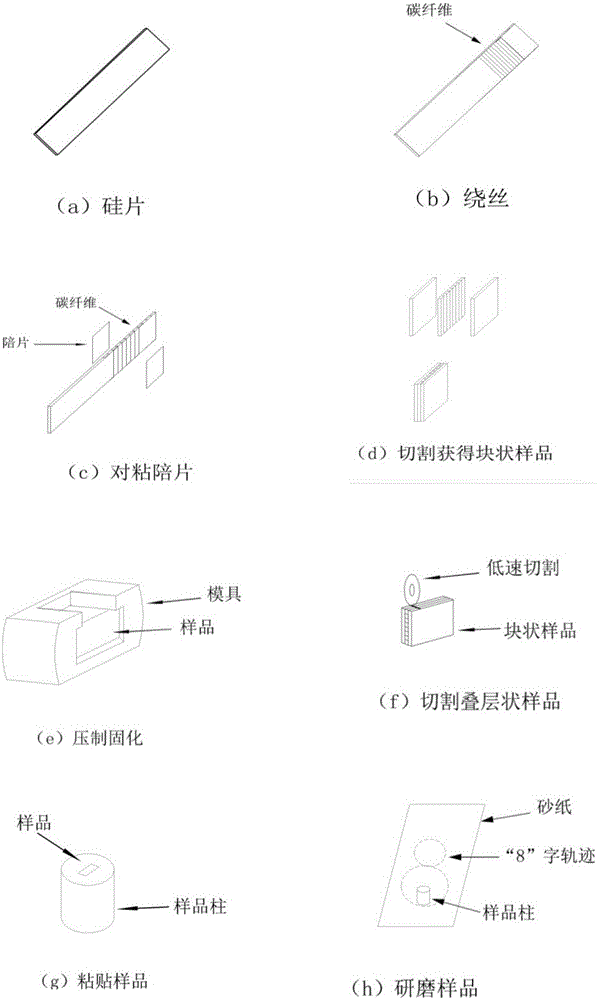Method for producing carbon fiber sample for Raman spectrum test
A Raman spectroscopy and carbon fiber technology, which is used in the preparation of carbon fiber samples, and the preparation of carbon fiber cross-sections and/or cross-section samples, can solve the problems of inability to obtain carbon fiber cross-section samples, large experimental errors, and low success rates. The effect of reduced experimental error and strong practicability
- Summary
- Abstract
- Description
- Claims
- Application Information
AI Technical Summary
Problems solved by technology
Method used
Image
Examples
Embodiment 1
[0039] A preparation method for a carbon fiber sample for Raman spectroscopic testing, comprising the following steps:
[0040] a. Silicon wafer gluing and wire winding: Apply glue on the rectangular parallelepiped silicon wafer, and put a bundle of carbon fiber filaments (the diameter of carbon fiber filaments is any one of 5-8 μm, take 10 carbon fiber monofilaments as a bundle) ( Uniformly and neatly) wound on the position where the glue is coated on the silicon wafer, and wound into a row of carbon fiber filaments with a width of 2mm;
[0041] b. Adhesive companion piece: apply glue on the carbon fiber filaments on the opposite sides of the silicon wafer, and then stick a companion piece on the opposite sides of the area where the carbon fiber filaments are wound, to obtain a sample with the companion piece pasted;
[0042] c. Curing: Put the sample pasted with the accompanying sheet into a mold (preferably a mold made of polytetrafluoroethylene), clamp it with a spring cli...
Embodiment 2
[0046] A preparation method for a carbon fiber sample for Raman spectroscopic testing, comprising the following steps:
[0047] a. Silicon wafer gluing and wire winding: apply glue on the cuboid silicon wafer, and put a bundle of carbon fiber filaments (the diameter of carbon fiber filaments is any one of 5-8 μm, take 30 carbon fiber monofilaments as a bundle) ( Uniformly and neatly) wound on the position where the glue is coated on the silicon wafer, and wound into a row of carbon fiber filaments with a width of 5mm;
[0048] b. Adhesive companion piece: apply glue on the carbon fiber filaments on the opposite sides of the silicon wafer, and then stick a companion piece on the opposite sides of the area where the carbon fiber filaments are wound, to obtain a sample with the companion piece pasted;
[0049] c. Curing: Put the sample pasted with the accompanying sheet into a mold (preferably a mold made of polytetrafluoroethylene), clamp it with spring clips, heat and cure at 1...
Embodiment 3
[0053] A preparation method for a carbon fiber sample for Raman spectroscopic testing, comprising the following steps:
[0054] a. Silicon wafer gluing and wire winding: apply glue on the rectangular parallelepiped silicon wafer, and put a bundle of carbon fiber filaments (the diameter of carbon fiber filaments is any one of 5-8 μm, it is better to take 20 carbon fiber monofilaments) One bundle) (uniformly and neatly) wound on the position where the glue is coated on the silicon wafer, and wound into a row of carbon fiber filaments with a width of 3mm;
[0055] b. Adhesive companion piece: apply glue on the carbon fiber filaments on the opposite sides of the silicon wafer, and then stick a companion piece on the opposite sides of the area where the carbon fiber filaments are wound, to obtain a sample with the companion piece pasted;
[0056] c. Curing: Put the sample pasted with the accompanying sheet into a mold (preferably a mold made of polytetrafluoroethylene), clamp it wi...
PUM
 Login to View More
Login to View More Abstract
Description
Claims
Application Information
 Login to View More
Login to View More - R&D
- Intellectual Property
- Life Sciences
- Materials
- Tech Scout
- Unparalleled Data Quality
- Higher Quality Content
- 60% Fewer Hallucinations
Browse by: Latest US Patents, China's latest patents, Technical Efficacy Thesaurus, Application Domain, Technology Topic, Popular Technical Reports.
© 2025 PatSnap. All rights reserved.Legal|Privacy policy|Modern Slavery Act Transparency Statement|Sitemap|About US| Contact US: help@patsnap.com



